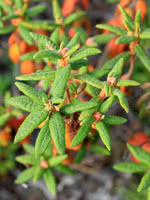Mon-Fri 9am - 5pm Mountain time
Sea Buckthorn (Seaberry) vs Labrador Tea
Hippophae rhamnoides l.
Rhododendron groenlandicum (Ledum groenlandicum)
NOT AVAILABLE THIS SEASON - MIGHT RETURN
Sea Buckthorn, aka Seaberry, is a nitrogen fixing shrub that produces attractive berries high in vitamin C.
While we can't confirm claims that the berries are effective in treating various ailments, many people believe consuming the berries helps with arthritis, infections, and asthma, among other things.
Sea Buckthorn plants have attractive pale silvery-green leaves, dense branches, and large thorns, people like to grow in ornamental hedges or as a first row in a shelterbelt.
Note: these plants typically reach maturity and make their sex easily known (females producing fruit) in their 3rd or 4th year of growth. Our seedlings are too young to identify their sex.
Labrador Tea is slow-growing evergreen shrub native to the boreal forests of Canada.
It thrives in wet, swampy conditions.
Labrador Tea has narrow, leathery, dark green leaves, topped by a cluster of white flowers in the spring. It is a perfect ornamental shrub for boggy, wet areas of your property.
Sea Buckthorn (Seaberry) Quick Facts
Labrador Tea Quick Facts
Toxicity: slightly toxic if ingested
In row spacing: 0.9 - 1.2 m (3 - 4 ft)

